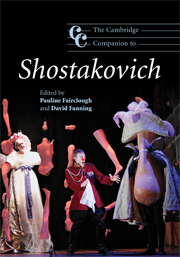Book contents
- Frontmatter
- Introduction
- PART I Instrumental works
- PART II Music for stage and screen
- PART III Vocal and choral works
- PART IV Performance, theory, reception
- 12 A political football: Shostakovich reception in Germany
- 13 The rough guide to Shostakovich's harmonic language
- 14 Shostakovich on record
- 15 Jewish existential irony as musical ethos in the music of Shostakovich
- Notes
- Select bibliography
- Index
15 - Jewish existential irony as musical ethos in the music of Shostakovich
from PART IV - Performance, theory, reception
Published online by Cambridge University Press: 28 September 2011
- Frontmatter
- Introduction
- PART I Instrumental works
- PART II Music for stage and screen
- PART III Vocal and choral works
- PART IV Performance, theory, reception
- 12 A political football: Shostakovich reception in Germany
- 13 The rough guide to Shostakovich's harmonic language
- 14 Shostakovich on record
- 15 Jewish existential irony as musical ethos in the music of Shostakovich
- Notes
- Select bibliography
- Index
Summary
Irony is a key element in the music of Shostakovich. Its presence is so conspicuous and varied that it allows the creation of a taxonomy of subtypes: satire, parody, the grotesque, and even a new type that has been tentatively described as existential. Shostakovich used satirical irony to criticize; parody as a compositional device; the grotesque as a quasi-philosophical statement on human nature; and, possibly, existential irony to present an ethical approach to life, embracing the amalgam of both dysphoric and euphoric aspects of human existence as a source of our aesthetic experience. Although some of the composer's output has been interpreted as existentialist in other sources, no systematic analysis has been offered to explain how existential ideas, let alone existential irony, are correlated with the music itself.
Existentialism is a rather vague concept that includes literary, philosophical and psychological writings whose common denominator is a concern with human existence and the search for its significance. Its vagueness and the variety of approaches to it make the detection of its musical correlations problematic, because such correlations require a semantic correlative sufficiently characterized to allow a direct, reasonably undisputable interpretation. In spite of this difficulty, there are still several traits of existential thought that are agreed by most writers on the subject: above all, a generalized dysphoric approach to human existence and a strong feeling of its senselessness and lack of direction.
- Type
- Chapter
- Information
- The Cambridge Companion to Shostakovich , pp. 350 - 367Publisher: Cambridge University PressPrint publication year: 2008
- 1
- Cited by

